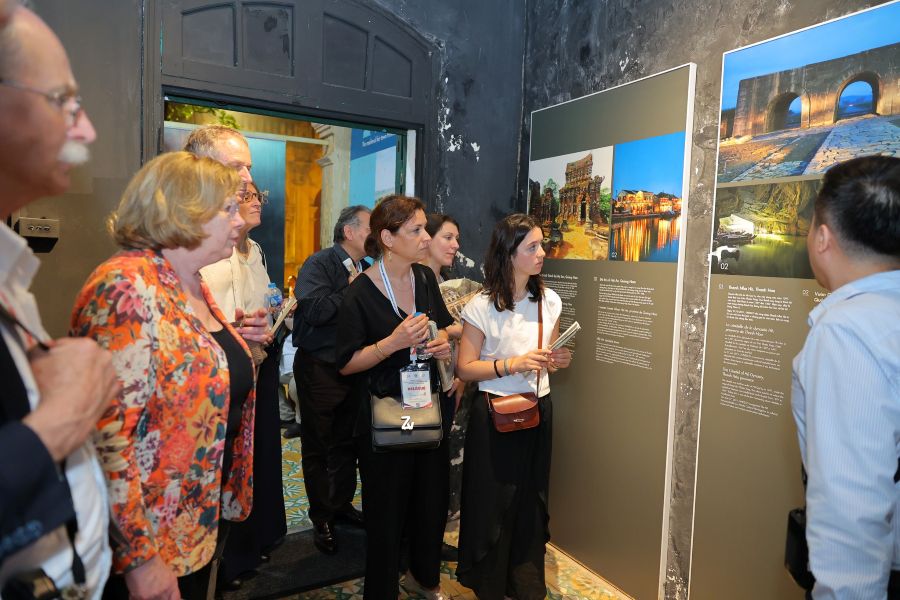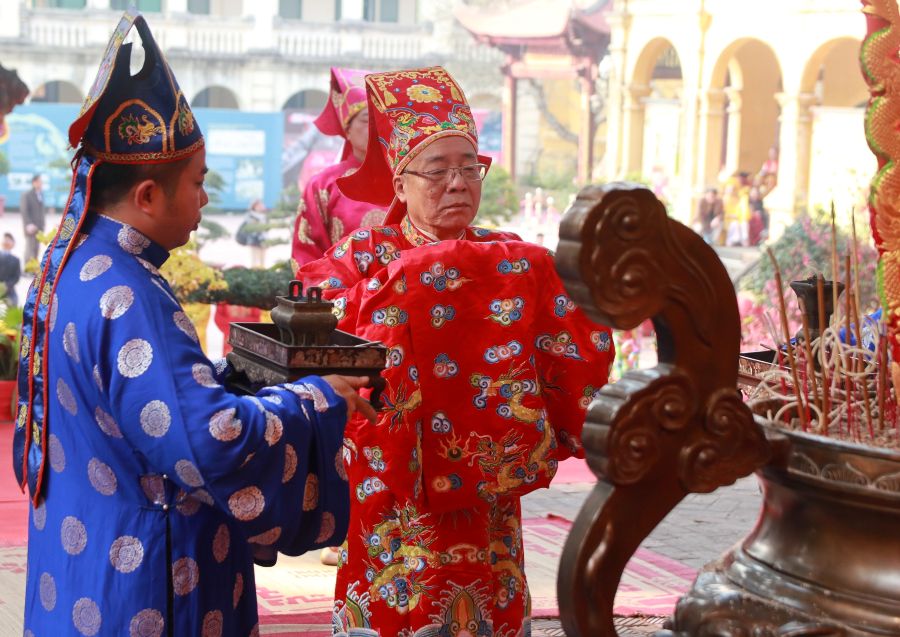As a highlight of the Hanoi Festival of Creative Design 2024, the Vietnam National Museum of History played host to an insightful conference titled “Architectural Heritage in the Creative City.”
| Foreign visitors captivated by the Hanoi Festival of Creative Design 2024. Photo: Huy Pham/ The Hanoi Times |
With the theme “Architectural Heritage in the Creative City,” the event was a collaborative effort between the Hanoi Department of Culture and Sports and Architecture Magazine, the official publication of the Vietnam Association of Architects.
A City of Rich Cultural Tapestry
The conference aimed to “infuse vitality into architectural heritage within the contemporary landscape.” It brought together renowned experts in architecture, history, and public memory, showcasing the capital’s iconic architectural heritage sites through a journey spanning the past, present, and future.
As a proud member of UNESCO’s Creative Cities Network, Hanoi has strategically prioritized creativity and the creative economy as the driving forces behind its dynamic, inclusive, and sustainable development.
In this transformative process, cultural heritage serves not only as the foundational pillar, both tangible and intangible, for establishing a Creative City, but it also actively contributes to crafting the city’s creative spaces.
Architectural relics, alongside cultural heritage, often serve as the breeding ground for community-driven cultural activities. They are nourished and transmitted by the community itself. Thus, when harmonized with modern society, these relics can foster community engagement, attract diverse individuals, and unlock the creative potential across all socioeconomic strata.
Hanoi, with its millennium-long status as the country’s center, boasts a diverse array of architectural masterpieces. These structures collectively form a heritage block, contributing to the city’s captivating allure.
| International visitors exploring the Thang Long Imperial Citadel. Photo courtesy of the relic site |
Notably, the relics along Ly Thai To, Le Thanh Tong, and Trang Tien streets have significantly influenced Hanoi’s modern aesthetic, shaping the city’s appearance from the late 19th century through to the second half of the 20th century.
Transforming Heritage into Economic Catalysts
Hanoi is a treasure trove of cultural heritage, as evidenced by the Hanoi Department of Culture and Sports’ inventory of 5,922 relics. This includes one World Heritage Site, the illustrious Thang Long Imperial Citadel, 21 special national relic clusters, and a wealth of over 1,700 intangible cultural heritage items, all meticulously cataloged and protected.
This abundance of cultural heritage presents Hanoi with a unique opportunity to captivate and engage tourists. However, the challenge lies in translating this heritage into economic and social catalysts that fuel the city’s holistic development.
To address this, cultural and tourism management entities have been proactive in crafting novel experiences rooted in the city’s heritage. A stellar example is the Hoa Lo Prison relic, which now offers the highly sought-after “Sacred Night” tour, requiring bookings months in advance. Similarly, the Thang Long Imperial Citadel has introduced the “Decoding Thang Long Imperial Citadel” night tour, resulting in a substantial increase in weekly visitor numbers to 2,000.
| A traditional ritual practice at the Thang Long Imperial Citadel, encapsulating history and culture. |
The Temple of Literature has also embraced innovation with the launch of the “Quintessence of Education” tour. This immersive experience incorporates 3D mapping lighting technology and interactive elements, attracting a significant surge in visitors, as noted by Le Xuan Kieu, Director of the Center for Cultural and Scientific Studies of the Temple of Literature.
While these initiatives are commendable, there is still much to be done to harness Hanoi’s heritage for sustainable cultural and economic growth. This endeavor demands continued innovation, strategic planning, and creative approaches to tourism and cultural preservation from heritage managers.
Igniting Hanoi’s Cultural Legacy
The annual Creative Design Festival stands as a pivotal initiative in Hanoi’s mission to “transform heritage into assets.”
Architect Hoang Dao Kinh, speaking at the “Architectural Heritage in the Creative City” conference, reflected, “Perhaps we have become desensitized to Hanoi’s treasures due to our familiarity, but there’s no denying that Hanoi is a city brimming with uniqueness. The Hanoi Creative Design Festival has ignited a spark, reminding us not to fall into apathy regarding the city we call home. I applaud the architects and artists who have courageously utilized modern science and technology to breathe new life into our heritage sites.”
| The Hanoi Festival of Creative Design is an annual celebration of the capital’s cultural industries, showcasing the creativity of its businesses and citizens. Photo: Minh An/ The Hanoi Times |
Architect Nguyen Hong Quang shared similar sentiments, stating, “The festival presents a captivating space for numerous beneficiaries, especially the creative community. It provides us with a platform to exhibit our works, bridge disciplines, and introduce our latest creations. Each piece is like a gateway, inviting the public to discover the priceless gems that are our architectural heritage sites.”
In addition to exploring the role of architectural heritage in the creative city, experts also delved into thoughtful discussions regarding the sustainability of creations emerging from these heritage sites.
Drawing on past festival experiences, Quang highlighted the organizers’ focus on producing sustainable works this year. The pavilions are designed to be more visitor-friendly and situated in stable areas, such as the Vietnam National History Museum courtyard, to hold visitors’ attention for longer.
Pham Tuan Long, Chairman of the Hoan Kiem People’s Committee, shared his insights based on his extensive experience in revitalizing numerous architectural heritage sites in the district. He emphasized the importance of inter-unit cooperation in operating and utilizing these creations post-festival. With the enactment of the Capital Law, he hopes to see new avenues for collaboration, effectively putting heritage sites and unique works to good use even after the festival concludes.
The conference brought together a wealth of perspectives from architectural researchers and offered tangible solutions to preserve and promote this precious heritage. Moreover, it fostered the formation of a knowledge community, where a shared understanding of local heritage is cultivated among the owners of Hanoi’s rich history—the people who call this city home today.
The Capital’s Captivating Comeback: Hanoi’s Tourism Takes Off
Hanoi, the vibrant and bustling capital of Vietnam, is a city that truly captivates travelers from all corners of the globe. With its unique blend of rich cultural heritage, stunning architecture, and vibrant atmosphere, it’s no wonder Hanoi remains a top choice for those seeking an authentic and memorable travel experience. The city’s energetic vibe, coupled with its charming historical allure, creates an unforgettable destination that leaves visitors with a lasting impression.
Hanoi’s Creative Design Festival: Unveiling the Capital’s Cultural Renaissance
The 2024 Hanoi Festival of Creative Design, an event centered on the theme of ‘Creative Intersection’, promises to transform the city’s historic heart with a plethora of activities. This celebration of the merging of traditional and innovative art will see over 100 events take place across seven of Hanoi’s most iconic heritage sites.

.jpg)









